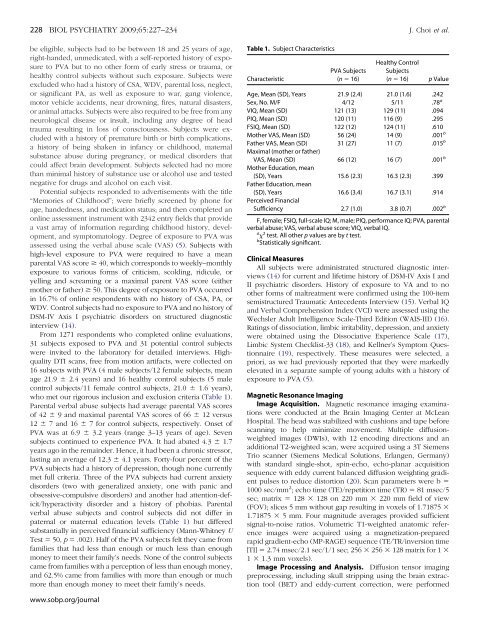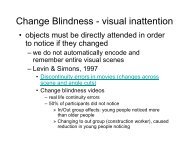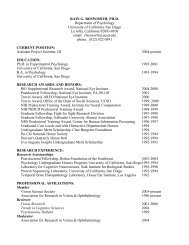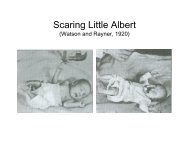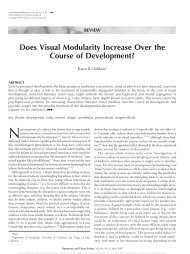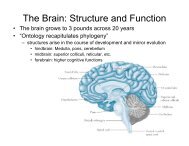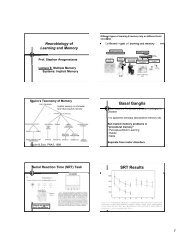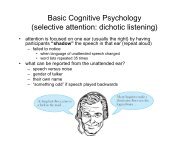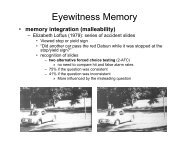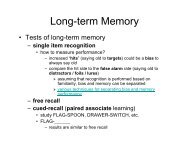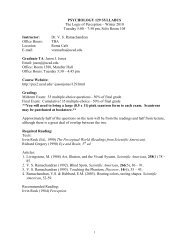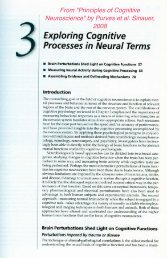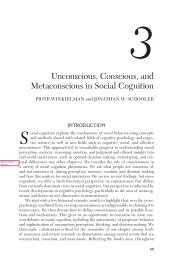Preliminary Evidence for White Matter Tract Abnormalities in Young ...
Preliminary Evidence for White Matter Tract Abnormalities in Young ...
Preliminary Evidence for White Matter Tract Abnormalities in Young ...
Create successful ePaper yourself
Turn your PDF publications into a flip-book with our unique Google optimized e-Paper software.
228 BIOL PSYCHIATRY 2009;65:227–234 J. Choi et al.<br />
be eligible, subjects had to be between 18 and 25 years of age,<br />
right-handed, unmedicated, with a self-reported history of exposure<br />
to PVA but to no other <strong>for</strong>m of early stress or trauma, or<br />
healthy control subjects without such exposure. Subjects were<br />
excluded who had a history of CSA, WDV, parental loss, neglect,<br />
or significant PA, as well as exposure to war, gang violence,<br />
motor vehicle accidents, near drown<strong>in</strong>g, fires, natural disasters,<br />
or animal attacks. Subjects were also required to be free from any<br />
neurological disease or <strong>in</strong>sult, <strong>in</strong>clud<strong>in</strong>g any degree of head<br />
trauma result<strong>in</strong>g <strong>in</strong> loss of consciousness. Subjects were excluded<br />
with a history of premature birth or birth complications,<br />
a history of be<strong>in</strong>g shaken <strong>in</strong> <strong>in</strong>fancy or childhood, maternal<br />
substance abuse dur<strong>in</strong>g pregnancy, or medical disorders that<br />
could affect bra<strong>in</strong> development. Subjects selected had no more<br />
than m<strong>in</strong>imal history of substance use or alcohol use and tested<br />
negative <strong>for</strong> drugs and alcohol on each visit.<br />
Potential subjects responded to advertisements with the title<br />
“Memories of Childhood”; were briefly screened by phone <strong>for</strong><br />
age, handedness, and medication status; and then completed an<br />
onl<strong>in</strong>e assessment <strong>in</strong>strument with 2342 entry fields that provide<br />
a vast array of <strong>in</strong><strong>for</strong>mation regard<strong>in</strong>g childhood history, development,<br />
and symptomatology. Degree of exposure to PVA was<br />
assessed us<strong>in</strong>g the verbal abuse scale (VAS) (5). Subjects with<br />
high-level exposure to PVA were required to have a mean<br />
parental VAS score 40, which corresponds to weekly–monthly<br />
exposure to various <strong>for</strong>ms of criticism, scold<strong>in</strong>g, ridicule, or<br />
yell<strong>in</strong>g and scream<strong>in</strong>g or a maximal parent VAS score (either<br />
mother or father) 50. This degree of exposure to PVA occurred<br />
<strong>in</strong> 16.7% of onl<strong>in</strong>e respondents with no history of CSA, PA, or<br />
WDV. Control subjects had no exposure to PVA and no history of<br />
DSM-IV Axis I psychiatric disorders on structured diagnostic<br />
<strong>in</strong>terview (14).<br />
From 1271 respondents who completed onl<strong>in</strong>e evaluations,<br />
31 subjects exposed to PVA and 31 potential control subjects<br />
were <strong>in</strong>vited to the laboratory <strong>for</strong> detailed <strong>in</strong>terviews. Highquality<br />
DTI scans, free from motion artifacts, were collected on<br />
16 subjects with PVA (4 male subjects/12 female subjects, mean<br />
age 21.9 2.4 years) and 16 healthy control subjects (5 male<br />
control subjects/11 female control subjects, 21.0 1.6 years),<br />
who met our rigorous <strong>in</strong>clusion and exclusion criteria (Table 1).<br />
Parental verbal abuse subjects had average parental VAS scores<br />
of 42 9 and maximal parental VAS scores of 66 12 versus<br />
12 7 and 16 7 <strong>for</strong> control subjects, respectively. Onset of<br />
PVA was at 6.9 3.2 years (range 3–13 years of age). Seven<br />
subjects cont<strong>in</strong>ued to experience PVA. It had abated 4.3 1.7<br />
years ago <strong>in</strong> the rema<strong>in</strong>der. Hence, it had been a chronic stressor,<br />
last<strong>in</strong>g an average of 12.3 4.1 years. Forty-four percent of the<br />
PVA subjects had a history of depression, though none currently<br />
met full criteria. Three of the PVA subjects had current anxiety<br />
disorders (two with generalized anxiety, one with panic and<br />
obsessive-compulsive disorders) and another had attention-deficit/hyperactivity<br />
disorder and a history of phobias. Parental<br />
verbal abuse subjects and control subjects did not differ <strong>in</strong><br />
paternal or maternal education levels (Table 1) but differed<br />
substantially <strong>in</strong> perceived f<strong>in</strong>ancial sufficiency (Mann-Whitney U<br />
Test 50, p .002). Half of the PVA subjects felt they came from<br />
families that had less than enough or much less than enough<br />
money to meet their family’s needs. None of the control subjects<br />
came from families with a perception of less than enough money,<br />
and 62.5% came from families with more than enough or much<br />
more than enough money to meet their family’s needs.<br />
www.sobp.org/journal<br />
Table 1. Subject Characteristics<br />
Characteristic<br />
PVA Subjects<br />
(n 16)<br />
Healthy Control<br />
Subjects<br />
(n 16) p Value<br />
Age, Mean (SD), Years 21.9 (2.4) 21.0 (1.6) .242<br />
Sex, No. M/F 4/12 5/11 .78 a<br />
VIQ, Mean (SD) 121 (13) 129 (11) .094<br />
PIQ, Mean (SD) 120 (11) 116 (9) .295<br />
FSIQ, Mean (SD) 122 (12) 124 (11) .610<br />
Mother VAS, Mean (SD) 56 (24) 14 (9) .001 b<br />
Father VAS, Mean (SD) 31 (27) 11 (7) .015 b<br />
Maximal (mother or father)<br />
VAS, Mean (SD) 66 (12) 16 (7) .001 b<br />
Mother Education, mean<br />
(SD), Years 15.6 (2.3) 16.3 (2.3) .399<br />
Father Education, mean<br />
(SD), Years 16.6 (3.4) 16.7 (3.1) .914<br />
Perceived F<strong>in</strong>ancial<br />
Sufficiency 2.7 (1.0) 3.8 (0.7) .002 b<br />
F, female; FSIQ, full-scale IQ; M, male; PIQ, per<strong>for</strong>mance IQ; PVA, parental<br />
verbal abuse; VAS, verbal abuse score; VIQ, verbal IQ.<br />
a 2 test. All other p values are by t test.<br />
b Statistically significant.<br />
Cl<strong>in</strong>ical Measures<br />
All subjects were adm<strong>in</strong>istrated structured diagnostic <strong>in</strong>terviews<br />
(14) <strong>for</strong> current and lifetime history of DSM-IV Axis I and<br />
II psychiatric disorders. History of exposure to VA and to no<br />
other <strong>for</strong>ms of maltreatment were confirmed us<strong>in</strong>g the 100-item<br />
semistructured Traumatic Antecedents Interview (15). Verbal IQ<br />
and Verbal Comprehension Index (VCI) were assessed us<strong>in</strong>g the<br />
Wechsler Adult Intelligence Scale-Third Edition (WAIS-III) (16).<br />
Rat<strong>in</strong>gs of dissociation, limbic irritability, depression, and anxiety<br />
were obta<strong>in</strong>ed us<strong>in</strong>g the Dissociative Experience Scale (17),<br />
Limbic System Checklist-33 (18), and Kellner’s Symptom Questionnaire<br />
(19), respectively. These measures were selected, a<br />
priori, as we had previously reported that they were markedly<br />
elevated <strong>in</strong> a separate sample of young adults with a history of<br />
exposure to PVA (5).<br />
Magnetic Resonance Imag<strong>in</strong>g<br />
Image Acquisition. Magnetic resonance imag<strong>in</strong>g exam<strong>in</strong>ations<br />
were conducted at the Bra<strong>in</strong> Imag<strong>in</strong>g Center at McLean<br />
Hospital. The head was stabilized with cushions and tape be<strong>for</strong>e<br />
scann<strong>in</strong>g to help m<strong>in</strong>imize movement. Multiple diffusionweighted<br />
images (DWIs), with 12 encod<strong>in</strong>g directions and an<br />
additional T2-weighted scan, were acquired us<strong>in</strong>g a 3T Siemens<br />
Trio scanner (Siemens Medical Solutions, Erlangen, Germany)<br />
with standard s<strong>in</strong>gle-shot, sp<strong>in</strong>-echo, echo-planar acquisition<br />
sequence with eddy current balanced diffusion weight<strong>in</strong>g gradient<br />
pulses to reduce distortion (20). Scan parameters were b <br />
1000 sec/mm 2 ; echo time (TE)/repetition time (TR) 81 msec/5<br />
sec; matrix 128 128 on 220 mm 220 mm field of view<br />
(FOV); slices 5 mm without gap result<strong>in</strong>g <strong>in</strong> voxels of 1.71875 <br />
1.71875 5 mm. Four magnitude averages provided sufficient<br />
signal-to-noise ratios. Volumetric T1-weighted anatomic reference<br />
images were acquired us<strong>in</strong>g a magnetization-prepared<br />
rapid gradient-echo (MP-RAGE) sequence (TE/TR/<strong>in</strong>version time<br />
[TI] 2.74 msec/2.1 sec/1/1 sec; 256 256 128 matrix <strong>for</strong> 1 <br />
1 1.3 mm voxels).<br />
Image Process<strong>in</strong>g and Analysis. Diffusion tensor imag<strong>in</strong>g<br />
preprocess<strong>in</strong>g, <strong>in</strong>clud<strong>in</strong>g skull stripp<strong>in</strong>g us<strong>in</strong>g the bra<strong>in</strong> extraction<br />
tool (BET) and eddy-current correction, were per<strong>for</strong>med


